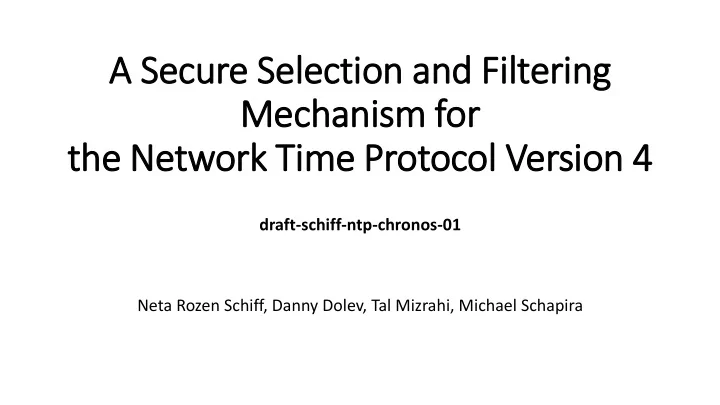

A Secure Selection and Filt iltering Mechanism for the Network Tim ime Protocol Version 4 draft-schiff-ntp-chronos-01 Neta Rozen Schiff, Danny Dolev, Tal Mizrahi, Michael Schapira
Reminder: Threat Model The attacker: • Controls a large fraction of the NTP servers in the pool (say, ¼) • Capable of both deciding the content of NTP responses and timing when responses arrive at the client • Malicious NTP server NTP server NTP server …… . client
Reminder: Chronos Architecture Chronos ’ design combines several ingredients: • Rely on many NTP servers Generate a large server pool (hundreds) per client E.g., by repeatedly resolving NTP pool hostnames and storing returned IPs Sets a very high threshold for a MitM attacker • Query few servers Randomly query a small fraction of the servers in the pool (e.g., 10-20) Avoids overloading NTP servers • Smart filtering Remove outliers via a technique used in approximate agreement algorithms Limits the MitM attacker ’ s ability to contaminate the chosen time samples
New in draft 001 001: : Precision Vs. . Security • Chronos compared to NTPv4: • Greater variety of sampled servers over time • Avoids (NTPv4) source quality filters • Provable security guarantees • Possible adverse effects on precision and accuracy. • Bounded by Chronos' ω parameter (25ms) • Insignificant for many applications of interest • Hybrid approach (when precision and accuracy are critical): • By default NTPv4 updates the local clock • When a threat or evidence of attack is detected (based on Chronos ’ samples), Chronos time is considered instead.
New comments for draft 001 001 • Use Chronos externally to enhance the security of NTPv4 • Use Chronos as a new filter (or verification step) within NTPv4 We thank Dieter and Greg for useful discussions!
Thank You \ See full draft (@IETF): https://tools.ietf.org/id/draft-schiff-ntp-chronos-01.html
Recommend
More recommend